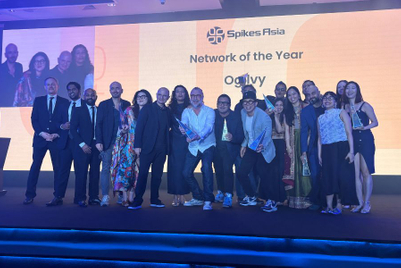
| PARTNER CONTENT |
As a response to changes in the market over the past three years, Chinese consumers are coming online in ever greater numbers. Tencent’s Weixin platform is a popular app that includes several services — instant messaging, status updates, photo and video sharing, and interest-based communities. These services are available to the rest of the world only via a suite of mostly non-interoperable apps.
With over one billion users on the platform, Weixin is a huge aggregator of audiences within China.
To discover how marketers can leverage the myriad opportunities it offers, we spoke to several key personnel at Tencent Marketing Solution on the sidelines of the Cannes Lions Festival of Creativity including Kiki Fan, general manager of industrial sales operations; Ethen Zhang, deputy general manager; and Dan Shu, head of luxury and beauty goods industry.
Subjects covered include recent developments on Weixin that have made the platform more marketing-friendly, the game-changing impact of mini programs or apps that exist within its ecosystem, and how marcom networks can use its suite of services to deliver the best results for their clients. The interview was edited for clarity and brevity.
In recent years, what are some of the most remarkable consumer trends in China?
Kiki Fan (KF): In recent years, Chinese consumers remain very comfortable with cashless payments with the usage rate 2.5 times higher than the global average. The growth and penetration of mobile internet has also seen a significant increase of close to 30% compared to three years ago, surpassing the global average of around 19%.
Online purchase journeys have undergone changes as consumers diversify their preferences. Social commerce is on the rise, while the contribution of e-commerce giants has declined to around 74% from 83% three years ago.
Brands are tailoring their offerings to align with the interests and passions of consumers on social platforms like Weixin. In addition, Weixin mini programs — which are applications built within the Weixin platform, provide consumers with a seamless experience. These mini programs allow access to a brand’s website (Brand.com 2.0) without having to leave Weixin, and offer a range of functionalities, including marketing, CRM, purchase, and customer service.
Dan Shu (DS): The youth segment is a key driver of the luxury market and contributes about 50% in terms of the spending power. They come not only from Shanghai and Beijing but also from major cities in different provinces. These consumers have transitioned from purchasing luxury goods through travel to other countries or cities to buying online. Watches and jewellery have experienced the fastest growth since they are considered valuable assets. Shoes and bags, as entry-level luxury items, rank as the second-largest category. Beauty products also show significant growth.
With such a release of pent-up demand, how do brands stand out?
DS: Branding and brand assets hold utmost significance for luxury brands, especially in the context of China’s vibrant festival culture that encompasses both Western and local celebrations. The Chinese and Western Valentine’s Day, celebrated as love seasons, significantly contribute to about 40% of luxury consumption throughout the year.
The limitation on travel has fostered a renewed appreciation for cultural heritage among Chinese consumers. Leveraging cultural elements helps luxury brands stand out — to create unique and memorable experiences that resonate with local seasons and traditions fostering a fusion of cultural heritage and brand identity. Valentino has pioneered limited editions related to Chinese culture, setting a trend followed by many brands.
In terms of campaigns, brands are taking their flagship offline events online. I was at the Men’s Fashion Week in Milan — several brands like Gucci and Prada are moving their signature assets like fashion shows on to Weixin. Previously, technology was not mature enough to support this shift. But now, I highly recommend taking these events to digital platforms so consumers around the world —even those who cannot attend in person — can witness and engage with these events.
Another crucial aspect is activation: where Tencent Games, Tencent Music Entertainment Group, Tencent Video, and Tencent Sports come into play. These assets are leveraged to build awareness among young people, especially via games and esports.
Many luxury brands that previously had pop-up stores in 2020 and 2021 have now integrated themselves into Weixin mini programs. These mini programs serve multiple functions, including transactions, CRM, campaigns, and activation, and form a robust foundation for brands. Many brands on Weixin now have a clearer idea of customer behaviour and target audience. They can leverage media as an amplifier to accelerate growth.
Globally, marketers are struggling with attribution. How does Tencent help marketers navigate this space?
KF: On the customer engagement side, there have been many functionalities added. From our start as a messaging platform, we now see a billion people rally on the platform based on their interests and passions across Weixin official accounts, Weixin channels, and Weixin search. Consumers spend as much time on Weixin as they do browsing. New channels are created for consumers to exchange information, engage, and interact with content created either by the brands or influencers.
Key opinion leaders (KOLs) and creators with large followings are not necessarily the right choice. The Weixin platform offers a data-backed analysis to help clients understand which influencers and approaches are appropriate, including information on people reached, levels of interaction, resonance, and finally conversion. By examining different media approaches, we determine the best mix for a client.
Are you seeing any novel approaches from marketers?
KF: The metaverse is a hot topic. But it requires more than just technology to make it successful. It requires providing consumers with a compelling reason to engage. That is why we created the Coca-Cola Fans Universe within our metaverse (TMELAND*), based on social music content. Tencent has a strong foundation in gaming, allowing us to offer a wide range of digital content and cutting-edge technology. This enables us to create immersive, comprehensive online experiences within our ecosystem, providing marketers with innovative avenues to engage and connect with consumers.
In the past, new brands entering the Chinese market relied on physical touchpoints like hypermarkets and malls. But with changing market dynamics, brands have limited opportunities for face-to-face interactions. These brands turn to Weixin to connect with customers through various touchpoints offered by the platform.
Wonderlab, a local nutrition brand in China, has successfully leveraged Weixin mini programs for each new product launch, utilising KOLs and short videos to communicate product benefits. This innovative approach allows them to reach consumers outside traditional channels and gives a higher percentage of profit margins. Furthermore, brands can use Enterprise Weixin for seamless customer service, post-purchase.
Switching tracks to your relationship with the marketing communications business — can you tell us more about the joint business partnerships between Tencent and leading agencies?
Ethen Zhang (EZ): The joint business partnerships (JBP) between Tencent and leading agencies have been established for the past three years. Tencent sets annual strategic goals encompassing data, content, and even sales channel development, necessitating deep collaborations with agencies.
For agencies, Tencent’s comprehensive business ecosystem offers tremendous potential, but fully harnessing its benefits requires time, effort, and a commitment to continuous improvement to provide a better solution for clients.
The JBP programs function as guiding beacons, offering participating agencies early insights and other valuable services for their clients. They play a pivotal role in fostering creativity, consumer insight, effective marketing solutions, and accurate assessment. By connecting Tencent to international clients and leveraging their own overseas networks, the JBP program facilitates valuable connections for both the platform and the agencies involved.
What role does Tencent play in improving the efficacy of campaigns?
EZ: Improving marketing effectiveness is an ongoing challenge for agencies and media platforms, encompassing both branding and performance advertising.
For branding, our marketing intelligence tool RACE plays a pivotal role.
By conducting in-depth analysis of a brand’s target audience, RACE provides scientific recommendations for the optimal media mix. Agencies use this to develop customised strategies for clients, continuously measuring campaign metrics and evaluating the results.
On the performance advertising front, we have introduced a new task and publishing system. This system enables us to issue specific tasks to agencies based on client demands and media strategies, encompassing areas such as bidding, creativity, and media selection. Through this system agencies can closely observe the performance of the entire campaign and ensure that they optimise its effectiveness.
However, our focus goes beyond solely emphasising on the efficiency of the marketing funnel. We believe in creating a personalised space where brands can accurately identify and reach their target audience. By fostering meaningful interactions and private domain traffic, we aim to strengthen the connections between brand and consumer, enhancing the overall effectiveness of campaigns.
We help our clients understand how to optimise the frequency of communication. Are they wasting money? What is the optimal combination for brand and performance advertising?
KF: Brands often prioritise spending on transaction activities and direct sales, leveraging and “milking” their brand which can result in missed opportunities for long-term competition and brand power. We help clients in addressing various aspects of their marketing efforts, including evaluating media combinations, budgets, and new formats. By providing insights into customer conversion rates from competitors further down the funnel, we help our clients make informed decisions to strike the right balance between short-term gains and long-term success.
Additionally, our intelligence tool, RACE, leverages data from our diverse platforms to provide valuable insights for science-driven marketing strategies, optimising ad placement and maximising marketing efficiency. Starting from performance gap analysis, RACE helps identify short-term and long-term objectives, optimise campaign performance via people, content, and resource combination strategy; and finally validates all the methods and takes the essence for continuous testing and learning. These are the five steps RACE facilitates for easy data usage.
*TMELAND: the first virtual social music platform under Tencent Music Entertainment.


.jpg&h=334&w=500&q=100&v=20250320&c=1)

+(1).jpg&h=334&w=500&q=100&v=20250320&c=1)
.jpg&h=334&w=500&q=100&v=20250320&c=1)

.jpg&h=334&w=500&q=100&v=20250320&c=1)

.jpeg&h=334&w=500&q=100&v=20250320&c=1)
.jpg&h=334&w=500&q=100&v=20250320&c=1)








